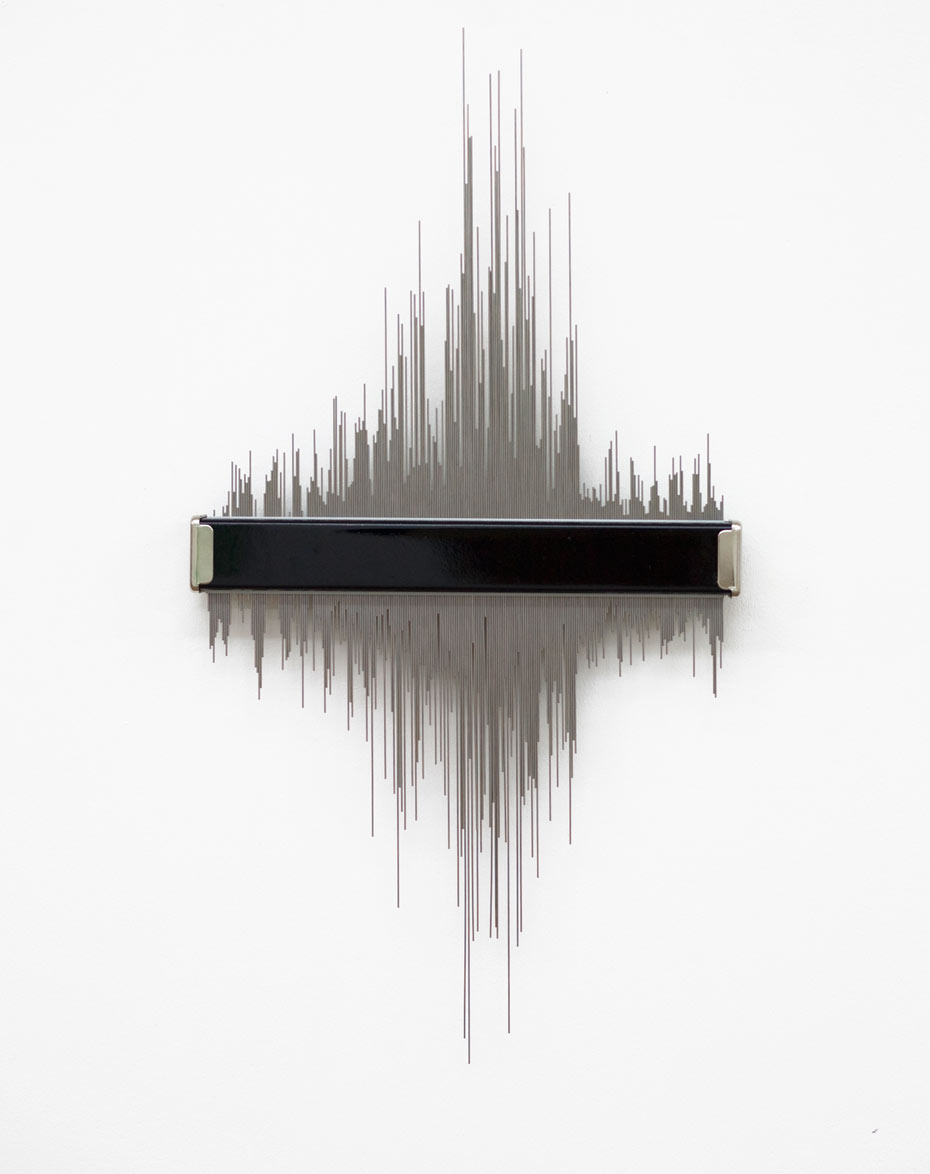Bloop, 2012, Conformateur, tiges en inox, 30 x 57 cm /
Slow down, 2012, Conformateur, tiges en inox, 30 x 40 cm /
Signal wow, 2012, Conformateur, tiges en inox, 30 x 40 cm
Retranscription de la forme du spectre sonore des signaux Bloop, Slow down et Wow.
« Le signal Bloop est un son d’ultra-basse fréquence détecté par le National Oceanic and Atmospheric Administration (NOAA) américain à plusieurs reprises durant l’été 1997. Bien qu’il recoupe le profil audio d’une créature vivante, il n’y a aucun animal connu qui pourrait avoir produit ce son. Si c’était un animal, il serait énorme, plus grand que la baleine bleue, d’après des scientifiques qui ont étudié le phénomène. Ce son pourrait provenir du bruit généré par un « tremblement de glace » d’un énorme iceberg. »
« Le son Slow down a été enregistré le 19 mai 1997 sur le réseau hydrophone autonome de l’océan Pacifique équatorial. Le son diminue lentement en fréquence durant environ sept minutes et avait une amplitude suffisante pour être détecté par trois senseurs à la latitude de 95°W et aux longitudes de 8°S, 0°E et 8°N, sur une distance de plus de 5 000 km. Son origine est à situer approximativement à 15°S, 115°W. L’origine du son est inconnue. »
« Le signal Wow! fut un fort signal radio à bande étroite capté le 15 août 1977 par le radiotéléscope The Big Ear de l’université de l’État de l’Ohio. Présumé extraterrestre, ce signal a duré 72 secondes et n’a plus été détecté depuis. C’est l’astrophysicien Jerry R. Ehman qui observa le phénomène. Stupéfié de voir à quel point le signal correspondait à la signature attendue d’un signal interstellaire dans l’antenne utilisée, Ehman a entouré au stylo le passage correspondant sur la sortie imprimée et a écrit le commentaire « Wow! » dans la marge à côté. Ce commentaire est devenu le nom du signal. »
Explications extraites de Wikipédia.
Bloop, 2012, contour gauge, stainless steel rods, 30 cm x 57 cm /
Slow Down, 2012, contour gauge, stainless steel rods, 30 cm x 40 cm /
Signal wow, 2012, contour gauge, stainless steel rods, 30 cm x 40 cm
A transcription of sound spectrograms of the signals Bloop, Slow down, and Wow
« Bloop was an ultra-low-frequency and extremely powerful underwater sound detected by the U.S. National Oceanic and Atmospheric Administration (NOAA) in 1997. The sound was consistent with the noises generated by ice quakes in large icebergs, or large icebergs scraping the ocean floor, but in 2002, was said to also be consistent with large marine animals. NOAA believes now the noise was ice-related. »
« Slow Down is a sound recorded on May 19, 1997, in the Equatorial Pacific Ocean by the U.S. National Oceanic and Atmospheric Administration. The source of the sound was most likely a large iceberg as it became grounded. The name was given because the sound slowly decreases in frequency over about 7 minutes. It was recorded using an autonomous hydrophone array. The sound has been picked up several times each year since 1997. One of the hypotheses on the origin of the sound is moving ice in Antartica. Sound spectrograms of vibrations caused by friction closely resemble the spectrogram of the Slow Down signal. This suggests the source of the sound could have been caused by the friction between a large ice sheet moving over land. »
« On August 15, 1977, a strong narrowband radio signal was detected by astronomer Jerry R. Ehman while working on a SETI project at the Big Ear radio telescope of the Ohio State University. The signal appeared to come from the constellation Sagittarius and bore the expected hallmarks of extraterritorial origin. Impressed by the result, Ehman circled the signal on the computer printout and wrote the comment ‘Wow!’ on its side, which is how the event has since been referred to. The entire signal sequence lasted for the full 72-second window that Big Ear was able to observe it, but has not been detected since, despite several subsequent attempts by Ehman and other astronomers. Various hypotheses have been put forward with regard to the signal’s origin, either as terrestrial or otherwise, and the event has been the subject of significant media attention. »
Wikipedia.


